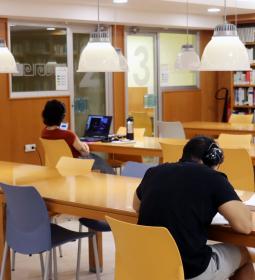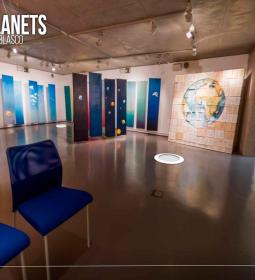The exhibition brings together for the first time pieces that "marked the daily lives of our ancestors"
With “Benidorm, a Trace Through the Time,” the city showcases its history at Boca del Calvari Museum

The archaeological exhibition ‘Benidorm, a Trace Through the Time’ is now open on the second floor of Museu Boca del Calvari, showcasing for the first time pieces excavated from local sites.
The exhibition, organised by the Department of Historical and Cultural Heritage, headed by Ana Pellicer, in collaboration with the Archaeological Museum of Alicante (MARQ), was presented as part of the 2025 Patron Saint Festivals Cultural Week. The event was attended by the Mayor of Benidorm, Toni Pérez; the Head of Historical Heritage, Ana Pellicer; the Councillors for Culture and Festivals, Jaime Jesús Pérez and Mariló Cebreros; other members of the council; and the regional deputy, José Ramón González de Zárate.
Also in attendance were Miguel Botella, archaeologist and curator of “Benidorm, Footprints of Time”; the director of the MARQ Archaeological Museum, Manolo Olcina; Feliciana Sala, Professor of Archaeology at the University of Alicante; the Queen and Junior Queen of the 2025 Women's Festival, Paula Pascual and Aitana Pérez, and their courts of honor; and the president of the Comissió (Festival Committee), Susana Martínez, among other representatives of civil society from the city and province of Alicante.
Ana Pellicer noted that the exhibition is being presented “in a very special year: the 700th anniversary of the founding of Benidorm.” The councilwoman highlighted the “sentimental value” of the exhibited material, which “brings together and displays for the first time in Benidorm objects found here” at archaeological sites such as Tossal de la Cala.
“These are very special pieces for the people of Benidorm,” the councilwoman emphasized, adding that they have heard about them for decades, but until now they have never been exhibited. This represents “a unique opportunity” to contemplate and admire objects that “marked the daily lives of our ancestors and are now a treasure of our heritage.”
“Benidorm, Footprints of Time” has been “a challenge and a dream” that has “become a reality today.” It summarizes the restoration work carried out on the Torre de les Caletes, Torre Morales, the Tossal de la Cala, and El Castell, and represents the enhancement of the historical heritage “making it available to everyone,” Pellicer explained.
Miguel Botella then explained that the exhibition consists of six display cases. The first is an introductory panel offering a brief historical overview of the archaeological interventions that have taken place in Benidorm, from Father Belda's 1943 excavation to the most recent in 2023, both at Tossal de la Cala.
The second display case exhibits Iberian ceramics and pieces from the MARQ Archaeological Museum; the third, objects from Tossal de la Cala, including a bone stylus, a bone ring, an iron dagger, and Iberian pottery painted with the image "Dance of the Warriors."
The fourth display case, the star of the exhibition, presents for the first time, 88 years after its excavation at the Iberian Sanctuary, the Iberian bull, the three Tanit figures (a lunar deity and a Punic goddess of fertility), and an Iberian lion head. The fifth display case is dedicated to Mediterranean trade, featuring Roman amphorae donated by Amparo Biosca ‘Amparito’, and the Miquel Tarradell collection. Finally, the sixth is dedicated to the medieval and modern periods, with objects from archaeological work carried out at El Castell and Torre de les Caletes.
In the center of the room, visitors can see a Roman stock, “the upper part of an anchor, weighing 350 kg, found in the 1960s,” Botella explained.
Toni Pérez then spoke, emphasizing the importance of knowing “everything that Benidorm once possessed and retained” and which now, “thanks to the collaboration with the MARQ,” citizens can enjoy. Addressing the younger women, the mayor explained that they were witnessing something that “for decades, the people of Benidorm have been unable to experience: a unique heritage, belonging to everyone, that has never been brought together before.”
The mayor reminisced about times past, “more than 40 years ago,” when Benidorm “lamented how little of its historical heritage it had left.” A time when a housing development was being built on the Tossal hill. “Fortunately,” he explained, “there were concerned people who unearthed pieces from that site, pieces that most of us had never seen.”
“People were saying,” the mayor continued, “that Benidorm had lost the stocks, the bull, and nobody knew where the lion’s head was; only a few of us knew that the fish dish was in the MARQ Archaeological Museum.” Today, those pieces are what ‘Benidorm, Footprints of Time’ exhibits as “a tribute” to all those who “at some point dreamed that Benidorm could showcase its history in a gallery.”
The Magic of Theatre
After the doors opened at Boca del Calvari, many attendees were able to enjoy the final activity of the FMP Cultural Week: the performance of "The Magic of Theatre," which took place immediately afterwards in the Town Hall's Assembly Hall.
Directed by Manolo Troncoso and his Theatre Workshop, the group performed nine short, humorous scenes exploring the relationship between theatre, actors, and audience.









